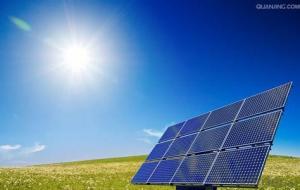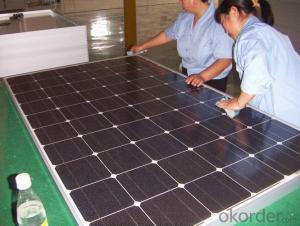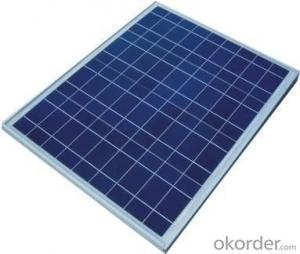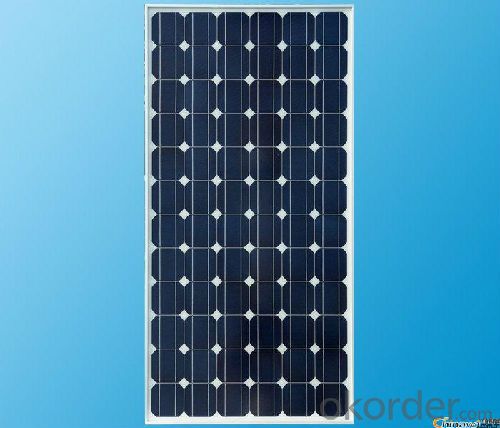Mono Solar Panel&Solar panel Mono 300watt 72 Mono with CE/UL/TUV/VDE/MCS/SON/PVCYCLE
- Loading Port:
- China Main Port
- Payment Terms:
- TT or LC
- Min Order Qty:
- -
- Supply Capability:
- 10000000 watt/month
OKorder Service Pledge
OKorder Financial Service
You Might Also Like
1.Structure of Solar Module Description
CNBM Solar's photovoltaic module is designed for designed for large electrical power requirement. It is the optimal choice for both on-grid and off-grid power systems. CNBM Solar offers high performance of power per square foot of solar array.
2.Main Features of the Solar Module
Quick Details
| Place of Origin: | Guangdong China (Mainland) | Brand Name: | CNBM solar | Model Number: | IK-P/M-1/300 |
| Material: | Polycrystalline Silicon | Size: | 1010*660*35mm | Number of Cells: | 72pcs solar panel cell |
| Max. Power: | 250w solar panels | City: | Shenzhen solar panel factory | Solar Panel Junction Box: | Ip65 rated |
| solar panels Isc: | 8.48 | solar panels Imp: | 7.90 | solar panels Vmp: | 35.78V |
| solar panels Frame: | Anodized aluminium alloy | solar panel Voc: | 44.98V | Solar Panels Connector: | compatible MC4 |
| Solar Panels Efficiency: | 16.8% | Solar Panels working time: | 25years |
Packaging & Delivery
| Packaging Detail: | Packed in wooden case for solar panel |
| Delivery Detail: | 10-15day after payment |
3.Solar Module Images
4.Solar Module Specification
Specifications
Low Price Solar Panel 1w to 300w
1) Can use Bosch Cell
2) high efficiency
3) OEM Solar panel
4) 25year Warranty
5.FAQ of Solar Module
1. Q: Do you have your own factory?
A: Yes, we have. Our factory located in Jiangyin city, jiangsu province.
2. Q: How can I visit your factory?
A: Before you take off from your country, please let us know. We will show you the way,or arrange time to pick you up if possible.
3. Q: Could you print our company LOGO on the nameplate and package?
A: Yes, we can do that.
4. Q: Do you accept custom design on size?
A: Yes, if the size is reasonable.
- Q:On how to connect a solar panel to a battery and then to a lightbulb,the project is offgrid..
- Hi Igor, this is a very simplified version of the system I'm implementing in my shed. I used a guide found on an Answers! member's website, you may find what you're looking for there. Check out the sources section.
- Q:Can solar panels be used to charge electric vehicles?
- Yes, solar panels can be used to charge electric vehicles. By installing solar panels on rooftops or in parking lots, the energy generated from the sun can be used to charge the batteries of electric vehicles, providing a clean and sustainable source of power. This helps reduce reliance on fossil fuels and promotes renewable energy use in transportation.
- Q:What is the impact of roof material on solar panels' performance?
- The choice of roof material can have a significant impact on the performance of solar panels. Certain materials, such as metal or asphalt shingles, are more conducive to efficient solar panel installation and operation. These materials provide a stable and sturdy base for mounting the panels, ensuring proper alignment and minimizing the risk of damage. Additionally, the reflectivity and heat absorption properties of the roof material can affect the overall efficiency of solar panels. Light-colored or reflective roofs can help reduce heat absorption, keeping the panels cooler and improving their performance. On the other hand, darker or less reflective roofs may lead to increased heat buildup, potentially reducing the efficiency of the panels. Ultimately, selecting a suitable roof material is crucial in maximizing the effectiveness of solar panels and optimizing their energy generation capabilities.
- Q:Can solar panels be used for outdoor lighting?
- Yes, solar panels can be used for outdoor lighting. Solar-powered outdoor lighting systems capture sunlight during the day and convert it into electricity, which is stored in a battery. This stored energy is then used to power outdoor lights during the night, offering an eco-friendly and cost-effective lighting solution.
- Q:How do solar panels affect the overall carbon footprint of a building?
- Solar panels can significantly reduce the overall carbon footprint of a building. By harnessing clean and renewable energy from the sun, solar panels generate electricity without emitting greenhouse gases. This means that the building relies less on fossil fuel-based electricity, reducing its carbon emissions. Additionally, solar panels can offset the energy consumption of a building, further minimizing its carbon footprint, making it a sustainable and environmentally-friendly choice.
- Q:Can solar panels be used in combination with wind turbines?
- Yes, solar panels can be used in combination with wind turbines. This combination is known as a hybrid renewable energy system. It allows for a more reliable and efficient generation of electricity as the two sources complement each other. Solar panels generate electricity during the day when there is abundant sunlight, while wind turbines generate electricity when there is sufficient wind. By combining these two sources, the system can produce electricity continuously, regardless of the time of day or weather conditions.
- Q:If my school uses 88240kWh of electricity per month and I have 000 50W solar panels running for 6 hours a day, does it mean it will take 88240kWh / {{[(50W x 3600s)*000]/000}kWh x 6} number of hours to generate that much electricity (88240kWh)?
- running six hours a day doesn't mean much. You need to look at the solar insulation charts for your school's geographical location to come up with a better factor. The easiest number for you to use is sun hours. For example, Washington DC averages 4.23 hours. Do a Yahoo search for sun hours and you should find lots of charts. Solar panels rated at 50W give this output at full sun near noon at full brightness (no clouds). The sun hour factor makes it easy to find the equivalent number of full brightness hours. So, using Washington DC as an example you have: 000 panels * 50W * 4.23 sunhours/day = 634kWh a day on average. You state your school uses 88240kWh/month which is 6274kWh a day. This would mean you need ten times more solar panels since there is no way to get more daylight. Be careful to put in all the units in your formula and cancel them out to make sure you don't end up with a nonsense result. The title of the question would be answered as followed: 50W/000 * 4.23 sunhours/day = 0.63kWh/day or 9kWh per month or 228kWh a year. These are annual averages. If you wanted a specific month, you would need the sun hours for that month. Hope this helps.
- Q:I have to get a lot of information on how solar panels are developed and distributed in America because I have to do two pages on this. Please help me get information in this I really need it!! Thankss...
- The first link below is one of the best sites for recent news about solar panels. You should be able to find stories about solar panels under development today. A little bit of the history: Solar panels have been around for about 50 years now. They were first used to power spacecraft. Solar power for domestic use started to develop rapidly in the 970's during the first oil crisis, but as energy prices fell in the 980's solar development slowed. Most of the large solar panel makers were purchased by large oil companies who seemed not to be too interested in solar. In the late 990's as concerns about both Peak Oil and Global Warming grew there was renewed interest in solar power and a number of new companies were started to develop new kinds of solar panels. Many of these new companies have grown larger than the older solar companies still owned by big oil companies. Over the last 7 years or so growth in the solar market has been explosive with a compound growth rate of almost 40% per year. In 2005 the solar industry for the first time started to consume more silicon than all other electronic industries combined resulting in a world wide silicon shortage that is still with use. New silicon refineries are coming on line and the shortage is expected to diminish by 2008 or 2009. Check out the two links below. They will help you a lot.
- Q:im trying to run my house with with solar panels, is it possible? if so please let me know how....i have a 6000 w inverter
- There are a variety of factors that come into play in order for you to calculate the answer. Additionally, there are a number of variables that can make the answer change over time. The number of solar panels you need to install to power your home will depend upon your electric power demands, the weather in your area, the angle of your roof, shade issues from nearby trees or buildings and the size of the cells. All of these factors are important and must be built into your calculations so that you can create the best solution for your home and your future needs.
- Q:how much electricity will produce in Kwh by a 000 W solar panel in a sunny tropical area per day (good sunlight at least 0 hour a day)
- The equivalent full sun hours in the tropics is around 5h a day, though the sun is around for 0 or more hours. This is to do with angles of a fixed panel. If the panel tracks the sun, it would be a bit longer, maybe 8 hours. The panel is rated for 000W in equivalent full sunlight at 25°C. As the panel temperature increases to 50 or 60°C, de-rate to 800W, and multiply that by 5h = 4kWh. This varies over the year. This is the energy the panel is capable of providing, which depends on just what it is connected to. Generally an MPPT controller (maximum power point tracking) will get the best result. If charging a battery, the energy is less, because of charging losses. This is a rubbery figure because the battery may not be a simple charge/discharge cycle, but allow about 75% of the 4kWh above. Any shading on part of the panel can reduce or stop production, or cause damage to the panel even. This is what the brown marks sometimes seen on some cells in a panel are usually caused by.
1. Manufacturer Overview |
|
|---|---|
| Location | |
| Year Established | |
| Annual Output Value | |
| Main Markets | |
| Company Certifications | |
2. Manufacturer Certificates |
|
|---|---|
| a) Certification Name | |
| Range | |
| Reference | |
| Validity Period | |
3. Manufacturer Capability |
|
|---|---|
| a)Trade Capacity | |
| Nearest Port | |
| Export Percentage | |
| No.of Employees in Trade Department | |
| Language Spoken: | |
| b)Factory Information | |
| Factory Size: | |
| No. of Production Lines | |
| Contract Manufacturing | |
| Product Price Range | |
Send your message to us
Mono Solar Panel&Solar panel Mono 300watt 72 Mono with CE/UL/TUV/VDE/MCS/SON/PVCYCLE
- Loading Port:
- China Main Port
- Payment Terms:
- TT or LC
- Min Order Qty:
- -
- Supply Capability:
- 10000000 watt/month
OKorder Service Pledge
OKorder Financial Service
Similar products
New products
Hot products






























